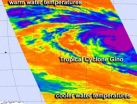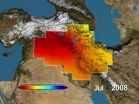(Press-News.org) SAN FRANCISCO – February 12, 2013 – New findings from a landmark clinical trial show that although certain gene variants may predict whether a person is likely to develop age-related macular degeneration (AMD), a potentially blinding eye disease that afflicts more than nine million Americans, these genes do not predict how patients will respond to Lucentis™ and Avastin™, the two medications most widely used to treat the "wet" form of AMD. This new data from the Comparison of AMD Treatment Trials (CATT), published online in Ophthalmology, the journal of the American Academy of Ophthalmology, found no significant association between four gene variants and outcomes that measured the patients' responses to treatment.
The CATT genetics research team wanted to learn whether the major AMD risk genes could be useful in tailoring treatment with Avastin and Lucentis to individual patients' needs to boost treatment effectiveness and safety for patients. The main CATT study had confirmed that both medications significantly reduce or even reverse vision loss in many patients with wet AMD, but that study also found that treatment effectiveness varied among patients. The CATT genetics study, led by Stephanie Hagstrom, Ph.D., at the Cole Eye Institute at the Cleveland Clinic, clearly showed that the major AMD risk alleles do not predict patients' response to treatment.
This genetics study cohort comprised 73 percent of the 1,149 CATT participants. Cohort patients were evaluated for four gene variants linked to AMD risk: CFH, ARMS2, HTRA1, and C3. The patients' genotypes were then compared to their responses to treatment with Lucentis or Avastin. Both medications are anti-vascular epithelial growth factor (anti-VEGF) therapies that work in similar ways to reduce or prevent abnormal blood vessel growth and leakage. The researchers found no significant associations among the four gene variants and the outcomes that measured the patients' responses to treatment, which were improvement or loss of visual acuity, the status of the retinal anatomy, and the number of medication injections given.
"Our genetic research team remains hopeful that gene variants that predict patient response to AMD treatments will be identified soon," said Dr. Hagstrom. "This would enable a significant leap forward in ophthalmologists' ability to individualize treatment and care plans for their patients."
The main CATT study was a multi-center clinical trial that was funded by the National Institutes of Health and led by Daniel F. Martin, M.D., Chairman of the Cole Eye Institute at the Cleveland Clinic. The study compared Lucentis and Avastin for effectiveness and safety in treating the wet form of AMD.
The findings of the CATT genetic study lend further weight to the American Academy of Ophthalmology's 2012 recommendation on the use of genetic testing . This study assessed the same four major gene variants that are most widely used in current AMD genetic tests and found that the treatment response in patients who carried the gene variants was no better or worse than in patients who did not. The Academy advises against routine genetic testing for AMD and other complex eye disorders until specific treatment or monitoring strategies have been shown in clinical trials to be of benefit to people with specific, risk-linked genotypes.
Wet AMD, also called neovascular AMD, can severely damage vision if not treated in time. About 10 percent of patients suffer from the wet form, in which abnormal blood vessels grow underneath the retina, the tissue at the back of the eye that is crucial to good vision. These vessels leak fluid or blood, which blurs or distorts the central vision that enables people to read, recognize faces, drive, and perform other daily activities. Scientists now think that about half of all cases of AMD are related to specific genes.
###
The American Academy of Ophthalmology recommends that everyone learn their risks for AMD and other common age-related eye diseases. People who are Caucasian, have a family history of AMD, are smokers, or have cardiovascular problems are more susceptible to AMD and may need to be followed closely by their ophthalmologist, a medical doctor who specializes in the diagnosis, medical and surgical treatment of eye diseases and conditions. To learn more about AMD, its risk factors and treatment options, visit geteyesmart.org.
Note to media: Contact Media Relations to request full text of the study and arrange interviews with experts
About the American Academy of Ophthalmology
The American Academy of Ophthalmology is the world's largest association of eye physicians and surgeons — Eye M.D.s— with more than 32,000 members worldwide. Eye health care is provided by the three "O's" – ophthalmologists, optometrists, and opticians. It is the ophthalmologist, or Eye M.D., who can treat it all: eye diseases, infections and injuries, and perform eye surgery. For more information, visit www.aao.org The Academy's EyeSmart® program educates the public about the importance of eye health and empowers them to preserve healthy vision. EyeSmart provides the most trusted and medically accurate information about eye diseases, conditions and injuries. OjosSanos™ is the Spanish-language version of the program. Visit www.geteyesmart.org or www.ojossanos.org to learn more.
About Ophthalmology
Ophthalmology, the official journal of the American Academy of Ophthalmology, publishes original, peer-reviewed reports of research in ophthalmology, including basic science investigations and clinical studies. Topics include new diagnostic and surgical techniques, treatment methods, instrument updates, the latest drug findings, results of clinical trials, and research findings. Ophthalmology also publishes major reviews of specific topics by acknowledged authorities. END
Major clinical trial finds no link between genetic risk factors and 2 top wet AMD treatments
New findings from the CATT study clarify value of genetic testing for serious eye condition
2013-02-13
ELSE PRESS RELEASES FROM THIS DATE:
Explosive breakthrough in research on molecular recognition
2013-02-13
Edmonton—Ever wonder how sometimes people still get through security with explosives on their person? Research done in the University of Alberta's Department of Chemical and Materials Engineering has revealed a new way to better detect these molecules associated with explosive mixtures.
A team of researchers including post-doctoral fellows Seonghwan Kim, Dongkyu Lee and Xuchen Liu, with research associate Charles Van Neste, visiting professor, Sangmin Jeon from the Pohang University of Science and Technology (South Korea), and Department of Chemical and Materials Engineering ...
Lower autism risk with folic acid supplements in pregnancy
2013-02-13
Women who took folic acid supplements in early pregnancy almost halved the risk of having a child with autism. Beginning to take folic acid supplements later in pregnancy did not reduce the risk. This is shown in new findings from the ABC Study and Norwegian Mother and Child Cohort Study published in the Journal of The American Medical Association (JAMA).
Women who took folic acid supplements from four weeks before conception to eight weeks into pregnancy had a 40 per cent lower risk of giving birth to children with childhood autism (classic autism). Use of folic acid ...
NASA sees Cyclone Gino wind up to wind down later
2013-02-13
NASA's Aqua satellite passed over Cyclone Gino as the storm continues to wind up in the southern Indian Ocean, consolidating and strengthening. Infrared data shows the storm has strengthened but it is headed for cooler waters which will weaken it in coming days.
On Feb. 12 at 0841 UTC, NASA Atmospheric Infrared Sounder (AIRS) instrument that flies aboard the Aqua satellite captured infrared imagery of Cyclone Gino that showed the storm developed a large area of very cold, high cloud top temperatures around its center indicating powerful thunderstorms. Cloud top temperatures ...
NASA provides satellite views of nor'easter lifespan
2013-02-13
NASA and NOAA satellites have provided animations and images of the coupling of two low pressure areas that created the now historic winter-time nor'easter that brought more than two feet of snow to portions of the New England states on Feb. 8 and 9, 2013. NASA released an animation of NOAA satellite imagery that shows the lifetime of the historic nor'easter.
The nor'easter dropped between 2 and 3 feet of snowfall over the U.S. Northeast and left more than 650,000 without power in eight states, according to the Associated Press. Several governors established travel bans ...
NASA satellites find freshwater losses in Middle East
2013-02-13
A new study using data from a pair of gravity-measuring NASA satellites finds that large parts of the arid Middle East region lost freshwater reserves rapidly during the past decade.
Scientists at the University of California, Irvine; NASA's Goddard Space Flight Center in Greenbelt, Md.; and the National Center for Atmospheric Research in Boulder, Colo., found during a seven-year period beginning in 2003 that parts of Turkey, Syria, Iraq and Iran along the Tigris and Euphrates river basins lost 117 million acre feet (144 cubic kilometers) of total stored freshwater. That ...
Gaps in mental health infrastructure for youth identified in many US communities
2013-02-13
ATLANTA- Mental health facilities that provide outpatient specialty services for youth are a critical element of the mental health care infrastructure, especially for youth who are uninsured or publically insured.
In a Viewpoint article in the February 13 issue of JAMA, Janet Cummings, PhD, assistant professor of health policy and management at Emory's Rollins School of Public Health, presents data from the 2008 National Survey of Mental Health Treatment Facilities and examines the extent to which gaps exist in the mental health treatment system for youth.
Based ...
In some dystonia cases, deep brain therapy benefits may linger after device turned off
2013-02-13
LOS ANGELES (Feb. 12, 2013) – Two patients freed from severe to disabling effects of dystonia through deep brain stimulation therapy continued to have symptom relief for months after their devices accidentally were fully or partly turned off, according to a report published online Feb. 11 in the journal Movement Disorders.
"Current thought is that symptoms will worsen within hours or days of device shut-off, but these two young men continued to have clinical benefit despite interruption of DBS therapy for several months. To our knowledge, these two cases represent the ...
Novel test streamlines testing for Huntington Disease
2013-02-13
Philadelphia, PA, February 13, 2013 – A new test may help to streamline genetic testing for Huntington Disease (HD) by generating accurate results, avoiding unnecessary additional testing, and improving turnaround time. The test, which uses chimeric or triplet repeat primed PCR (TP PCR) methodology, yielded results that were 100% concordant with standard genotyping methods in an analysis of 246 samples. The high sensitivity and specificity of the test could reduce the number of false negative results and facilitate both diagnosis and prognosis by correctly sizing the genetic ...
Scientists should advance management of behavioral norms
2013-02-13
Researchers should study how people's social and personal norms are influenced by behavior and use their insights to help governments promote pro-environmental actions, a distinguished group of scholars writes in the March issue of BioScience. The authors maintain that effective policies induce not only short-term changes in behavior but also long-term changes in norms. More effective management of social norms will be necessary, they write, to persuade the public to accept the inconvenience and expense of many environmental policies.
The interdisciplinary group, led by ...
Colorado DUI checkpoints lead to over 1,300 arrests in one weekend
2013-02-13
Colorado DUI checkpoints lead to over 1,300 arrests in one weekend
Article provided by James L. Finegan, P.C.
Visit us at http://www.fineganduilaw.com
The Colorado Department of Transportation (CDOT) reports that over 26,000 people in the state are arrested for driving under the influence, or DUI, every year. These arrests are not just from enforcement officers pulling over obviously impaired drivers or issuing tickets after an accident, but also the result of officers testing drivers at DUI checkpoints.
The state uses these checkpoints throughout the year, often ...
LAST 30 PRESS RELEASES:
Injectable breast ‘implant’ offers alternative to traditional surgeries
Neuroscientists devise formulas to measure multilingualism
New prostate cancer trial seeks to reduce toxicity without sacrificing efficacy
Geometry shapes life
A CRISPR screen reveals many previously unrecognized genes required for brain development and a new neurodevelopmental disorder
Hot flush treatment has anti-breast cancer activity, study finds
Securing AI systems against growing cybersecurity threats
Longest observation of an active solar region
Why nail-biting, procrastination and other self-sabotaging behaviors are rooted in survival instincts
Regional variations in mechanical properties of porcine leptomeninges
Artificial empathy in therapy and healthcare: advancements in interpersonal interaction technologies
Why some brains switch gears more efficiently than others
UVA’s Jundong Li wins ICDM’S 2025 Tao Li Award for data mining, machine learning
UVA’s low-power, high-performance computer power player Mircea Stan earns National Academy of Inventors fellowship
Not playing by the rules: USU researcher explores filamentous algae dynamics in rivers
Do our body clocks influence our risk of dementia?
Anthropologists offer new evidence of bipedalism in long-debated fossil discovery
Safer receipt paper from wood
Dosage-sensitive genes suggest no whole-genome duplications in ancestral angiosperm
First ancient human herpesvirus genomes document their deep history with humans
Why Some Bacteria Survive Antibiotics and How to Stop Them - New study reveals that bacteria can survive antibiotic treatment through two fundamentally different “shutdown modes”
UCLA study links scar healing to dangerous placenta condition
CHANGE-seq-BE finds off-target changes in the genome from base editors
The Journal of Nuclear Medicine Ahead-of-Print Tip Sheet: January 2, 2026
Delayed or absent first dose of measles, mumps, and rubella vaccination
Trends in US preterm birth rates by household income and race and ethnicity
Study identifies potential biomarker linked to progression and brain inflammation in multiple sclerosis
Many mothers in Norway do not show up for postnatal check-ups
Researchers want to find out why quick clay is so unstable
Superradiant spins show teamwork at the quantum scale
[Press-News.org] Major clinical trial finds no link between genetic risk factors and 2 top wet AMD treatmentsNew findings from the CATT study clarify value of genetic testing for serious eye condition


